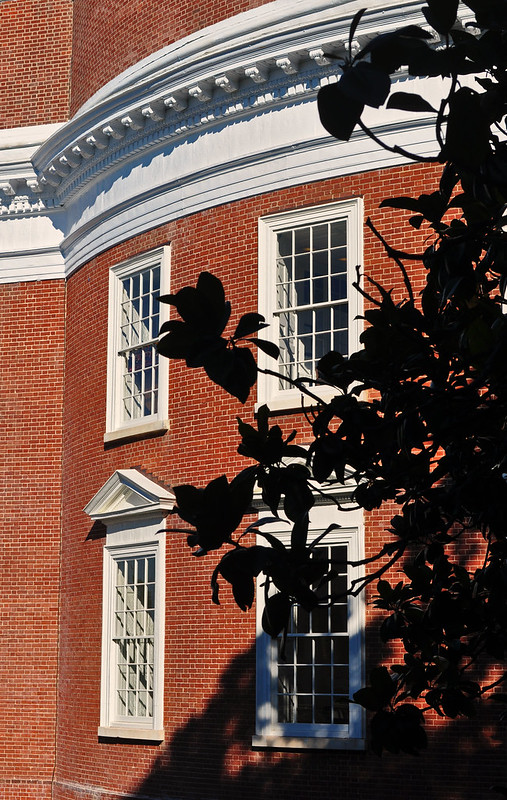This past weekend we left the flatland and headed west to the foot of the mountains. After a day floating on the James in the simple comfort of an inner tube, we spent the night in Charlottesville, one of my favorite places. Our hotel was just down the hill and a short walk from the University of Virginia (UVA). Sunday morning I was able to explore the grounds, camera in hand. In case you didn't know, the university was founded by Thomas Jefferson in 1819, and he was also its first architect. Jefferson was so proud of his role in the founding of UVA (the first non-sectarian university in the country) he had it added to his tombstone, though he opted not to mention he was our third president. Jefferson designed the Rotunda, the university's centerpiece, as a half scale rendition of Rome's Pantheon. Flanking either side of the Rotunda are a series of pavilions and colonnades, where faculty still teach students and where both are still housed. The buildings enclose a large lawn, and behind them are a series of garden spaces enclosed by serpentine walls, also designed by Mr. Jefferson. Together they form an "academical village", which is a UNESCO World Heritage site, and from which many an architect and city planner have drawn inspiration. Although the grounds were quiet on a Sunday morning in August, I could not help but feel the presence of the many others who have walked here before.
The Rotunda is currently under renovation, hence the black cloth covering the column capitols. It nearly burned to the ground in 1895, and has suffered some bad renovations. However, its current state is as close to what Jefferson would recognize, if he had lived long enough to see its completion.
On the top floor of the Rotunda is a library, and in the ceiling is an oculus shinning down like the eye of God, though Jefferson would probably disagree with me.
Edgar Allan Poe resided in this chamber, No. 13.
Other windows provide a more contemporary view. I wonder what Jefferson would think about our world-at-your-fingertips society?
The serpentine walls are not only attractive, I am sure they also appealed to Jefferson's practical side. The walls' shape makes them strong and consequently only require a one brick thickness.
Historians believe that the gardens were largely ornamental in nature, though things for the table were grown there as well. They also provided a quiet place to visit the privy, many of which still stand.
Your humble blogger had a chance to hug the largest ginkgo he has ever seen, the Pratt Ginkgo, and I need to plan a return visit to see its fall glory.
I hope this picture laden post has not crashed your computer or has used all your allotted data on your cell phone, but if you want to see more you can visit my Flickr page.





























Home.
ReplyDeleteWhat a beautiful place and lots of great pictures thank you for sharing:) i do enjoy stopping at those places more and more now. And those grounds look amazing!
ReplyDeleteI can tell from just looking at the pictures that you loved this place. I've still never been there, so I'm grateful for this preview. Wonderful photos.
ReplyDeleteI love Charlottesville! Your pictures are beautiful, as usual, and I chuckled at you hugging the ginkgo. Ginkgo is one of my favorite trees. Did you stop by Bodo Bagels? Best bagels ever. Next time I go I plan to visit Viette's Nurseries up the road a piece. Did you go to the nursery?
ReplyDeleteI've been there ages ago - my uncle, before he retired, taught English at UVA. Your photos capture Jefferson's genius so well.
ReplyDeleteYour area of the country is brimming with places of historic significance! U of V is beautiful! Thanks for sharing this great tour!
ReplyDeleteA beautiful place, one I would like to visit. Thank you for the tour.
ReplyDeleteAre you now officially a tree hugger? ;)
Wonderful post and photos! Thanks so much! It is not so far from us and your preview makes it go on our "to visit" list!
ReplyDeleteI believe Mr. Jefferson would be quite pleased with your blog and pictures. I loved them and they brought back wonderful memories of my time there. U.Va. is such a treasure and I'm grateful for the time I spent there.
ReplyDeleteThank you, Les, for this wonderful vicarious tour of UVA. The symmetry and balance of Jefferson's architectural vision renders a peacefulness even through the camera lens. These photos, as others have noted, are truly exceptional. They make me want to add UVA to an Eastern Seaboard trip (I'm lobbying my husband to go with me) to see Monticello, Mt. Vernon, Winterthur, Williamsburg, and others I cannot recall at the moment. Thank you.
ReplyDeleteOh I love that oculus, and thanks for my new word of the day.
ReplyDeleteLes, your images are wonderful. The colours are so rich and lush. Makes me want to visit the place.
wonderful visit thanks
ReplyDeleteI think I saw more in your photos than in my visit there years ago. Great images.
ReplyDeleteRay
Forget the oculus (beautiful) and the serpentine wall (amazing): I'd be hugging that tree too!
ReplyDeleteAmazing photos, I love the architectural ones, and that occulus is wonderful. I now crave a serpentine wall -which I cannot have. Ah well!
ReplyDeleteBeautiful architecture and what a treat to see your shots of it. I love the play of light on the staircase and the shot looking up at the top of the columns especially.
ReplyDelete